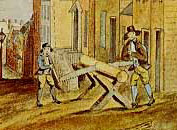By the 1720s, a small enclave of weavers had set up their looms on Albany's Southside. Chief among them were Isaac and Elizabeth Fryer.
In 1756, the census of households identifed eight weavers living in the city. At that time, Johannes Van Zandt, his son Johannes Van Zandt, Jr., alderman Johannes Ten Broeck, Andries Van Woert, and others lived in close proximity on Albany's Southside.
In an urbanizing America, the individual weaver was superceded by the mill early in the Industrial Revolution.
As late as 1815, the city directory identified four Albany residents as weavers.
You might follow this link to more information on Albany weavers on this website!

notes
The purpose of this exposition is to describe an essential part of the early Albany production economy. However, it is more concerned with the practitioners than the actual practice or products of weaving.
This senario copied from a woodcut printed in The Little Book
of Early American Crafts and Trades (first published
in 1807) illustrates the family economy at work in the home! The man
is weaving at his loom. The woman is spinning yarn. One boy appears
to be stripping wood from a log. The other is making a basket from
the stripped wood. If those activities produced cloth or baskets for
sale, that work would be part of the community's production
economy.
Home | Site Index | Navigation | Email | New York State Museum
first posted: 11/10/03